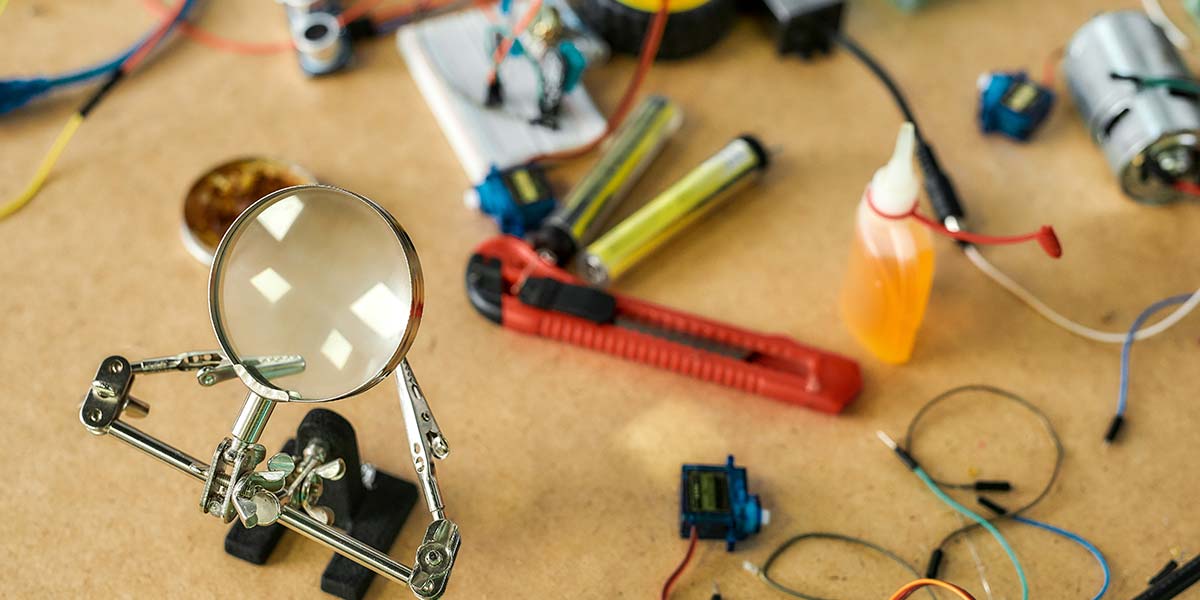
A Robotics Infrastructure for the Experimenter: Hardware Accessories
By Bryan Bergeron View In Digital Edition
Previously, we looked at the hardware essentials for a robotics experimenter, from a soldering iron to a 3D printer. Now, let’s consider a few hardware accessories — that is, add-ons to these essentials — that can increase your productivity and add to your enjoyment of designing and building robots.
USB Cables and Adapters
Working with microcontroller boards and sensors from different manufacturers and even different models from the same manufacturer means you need a library of adapters and cables. Does that board take a mini USB or a micro USB? Does that standard USB cable in your collection handle signal as well as power (many do not)?
You can either opt for a collection of different cables or go with a universal version that has multiple input and output options. My latest favorite is the Cerberus USB Cable from SparkFun ($7), which supports simultaneous use of standard, mini, and micro USB power and data.
Soldering Tools
Solder wick and a good soldering iron will only get you so far. Eventually, you’ll appreciate a good solder vacuum device to remove components and clear the solder pads on your printed circuit boards. I’ve used about every desoldering pump on the market, and there seems to be no correlation between price and longevity or performance. I’ve had good luck with the inexpensive Jajaplus desoldering pump ($8, Amazon).
Another must-have soldering accessory is a plastic tube to hold a small coil of solder. This may seem like a trivial nuisance, but I don’t like handling solder directly — even if it supposedly doesn’t contain lead. I simply buy a tube of solder for $2 and refill it from a 1/4 lb spool of lead-free solder as needed. It’s inexpensive insurance against heavy metal poisoning.
Meter Leads and Clips
Regardless of what you pay for a digital multimeter or other instrument, the standard leads and clips are inevitably lacking. I believe it’s a universal ploy to enhance sales of specialized or simply better made leads and clips. Whatever the case, I’m sold on upgrading. You can’t beat tips with nice sharp points that dig into the circuit board trace or cable conductor for a stable reading.
In situations where you need an extra arm or two, instrument leads with alligator clips instead of pointed probes are indispensable. Manufacturers offer leads that work with their specific instruments, but most are interchangeable. My favorite lead/clip upgrade brand is Fluke. I’ve had Fluke cables for nearly two decades that are still as good as new. Invest in good leads.
Power Cables
The power cables that ship with most robot platforms are simply too short. You can’t always lug your carpet roamer over to the workbench so that it’s within 36 inches of the power supply. My solution is to buy a spool of 16-gauge speaker wire and a few connectors, and make DC power extension cables at 5, 10, and 15 feet. You’ll wonder how you debugged your robots without them.
Cable and Lead Storage
Extra cables and leads aren’t useful unless you can find them at a moment’s notice. Avoid the shoe box approach and go for efficient hanging fixtures — sometimes referred to as claws — designed for cables. My favorite is a 14-slot holder from Pomona ($15, Amazon). It’s colorful, easy to mount, and the edges are finished so that they don’t cut into the cables. I have one for power cables and one for test leads. Amazon sells larger, more expensive claws as well.
3D Printer Alignment Tools
Assuring that your 3D printer platform is flat and at the proper distance from the printer nozzle is no small task. When the temperature changes significantly or I switch to a new filament formulation, I inevitably spend an hour or two with business cards and feeler gauges to get the distance right. Or, at least I used to.
Today, I use a Mitutoyo 2046SB dial test indicator ($90, Amazon), which has a resolution of 0.01 mm. It’s easily the most popular plunger-type gauge in use on hobby-grade 3D printers.
If you have deep pockets, then you might consider one of the many ultrasonic non-contact distance sensors on the market, but you can easily spend more on a sensor than on the printer proper.
That’s my list of top accessories. Your list might contain others, depending on the type and size of robots you work with. If so, please consider sharing your top accessories with your fellow readers. SV
Article Comments